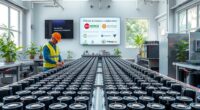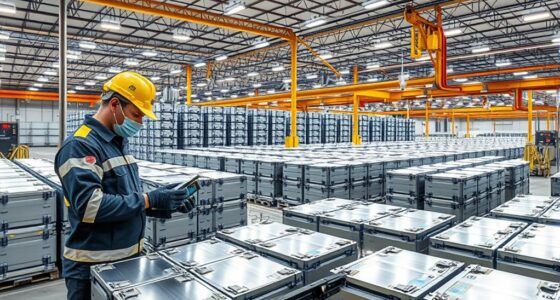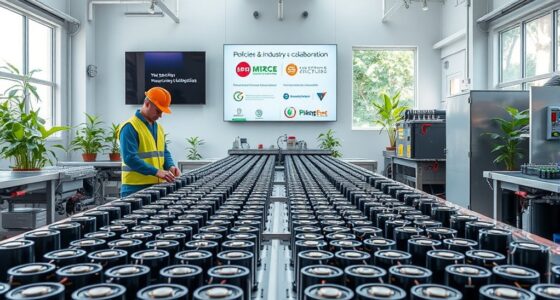When comparing repurposing and recycling, you’ll find that repurposing uses less energy and raw materials, making it more eco-friendly and cost-effective. It encourages creativity and reduces waste by finding new uses for old items, fostering a mindset shift towards sustainability. Recycling, while essential for materials that can’t be reused easily, requires more energy and infrastructure. Both strategies work best together for a greener, more sustainable approach—discover how combining them can enhance your environmental impact.
Key Takeaways
- Repurposing reduces energy and resource use by creatively reusing items, while recycling involves energy-intensive processing into raw materials.
- Repurposing is more cost-effective and accessible for small-scale efforts, requiring minimal infrastructure compared to recycling.
- Both strategies minimize waste; repurposing encourages creative reuse, decreasing the need for manufacturing new materials.
- Combining repurposing and recycling enhances environmental benefits and promotes sustainable waste management practices.
- Repurposing fosters community engagement and awareness, supporting a shift toward more eco-friendly consumption habits.

Have you ever wondered whether recycling or repurposing is the better way to reduce waste? Both approaches aim to lessen the burden of plastic waste and other materials on our environment, but they do so in different ways. Recycling involves breaking down used items into raw materials and creating new products, which often requires significant energy and resources. Repurposing, on the other hand, encourages creative reuse—transforming items into new uses without extensive processing. When you consider the environmental impact, repurposing often offers a more sustainable solution because it reduces the need for manufacturing new materials and cuts down on energy consumption. Instead of sending plastic waste to recycling centers, you can find innovative ways to give items a second life, which minimizes waste and conserves resources.
Repurposing reduces energy use and waste by creatively reusing items instead of recycling.
From an economic standpoint, repurposing can be more accessible and cost-effective. You don’t need specialized equipment or extensive infrastructure to creatively reuse items; instead, you leverage your imagination and basic tools. This makes repurposing appealing, especially for small-scale efforts or community projects that aim to reduce waste without heavy investments. Recycling, while *essential*, often involves costs related to collection, sorting, and processing facilities. These expenses can make recycling less economically feasible for some communities, especially in areas with limited infrastructure or funding. However, the economic benefits of repurposing also extend to local economies, as it can foster small businesses, craft industries, and community initiatives centered around creative reuse.
Furthermore, repurposing promotes environmental awareness and encourages a mindset shift. When you actively seek creative reuse, you become more conscious of your consumption habits and waste generation. This mindset helps you see discarded items—like glass jars, old furniture, or plastic containers—as opportunities rather than waste. It also inspires others to adopt similar practices, creating a ripple effect in reducing overall waste. Recycling still plays a *crucial* role in managing materials that are difficult to reuse, but it shouldn’t be the only strategy. Combining recycling with creative reuse amplifies your impact, reducing landfill overflow and conserving natural resources.
In essence, whether you choose to focus on repurposing or recycling depends on your goals, resources, and creativity. Repurposing offers a practical, eco-friendly way to combat plastic waste through creative reuse, while recycling remains *indispensable* for managing materials that can’t be easily repurposed. By understanding the strengths of both, you can make smarter choices that benefit the environment and your wallet, ultimately contributing to a more sustainable future.
Frequently Asked Questions
How Do Costs Compare Between Repurposing and Recycling?
You’ll find that repurposing usually costs less than recycling because it involves less processing and fewer materials. A cost analysis shows that repurposing can generate significant economic benefits by saving on labor and materials. Recycling, on the other hand, often requires specialized equipment and energy, increasing expenses. So, if you’re aiming for cost efficiency and economic gains, repurposing generally offers a more affordable, sustainable option.
Which Method Has a Greater Environmental Impact Overall?
You might think recycling is greener, but repurposing often has a lower environmental impact overall. While recycling extends a product’s lifespan, it consumes significant energy, generating emissions. Repurposing, on the other hand, minimizes energy consumption and keeps materials out of landfills longer. By giving items a new purpose, you reduce waste and environmental strain, making repurposing a more sustainable choice in many cases.
Are There Specific Materials Better Suited for Repurposing?
Certain materials, like wood, glass, and metal, are better suited for repurposing because of their high reuse potential and durability. You’ll find that these materials can be easily transformed into new items without extensive processing. Conversely, plastics and composites often have limited reuse potential and may require recycling instead. By choosing materials with high suitability for repurposing, you reduce waste and extend the lifecycle of valuable resources.
How Does Consumer Behavior Influence Repurposing and Recycling?
Think of your choices like steering a ship—your attitudes and habits set the course. When you value sustainability, you’re more likely to repurpose and recycle, shaping demand for eco-friendly options. A recent study shows consumer attitudes markedly influence recycling rates, while purchasing habits determine material flow. Your decisions ripple outward, inspiring others and creating a momentum that pushes industries toward greener practices. Every mindful action accelerates positive change.
What Policies Support Sustainable Repurposing and Recycling Practices?
You can benefit from policies that support sustainable practices by advocating for government incentives, such as tax breaks or grants, which encourage businesses and individuals to repurpose and recycle. Regulatory standards guarantee proper waste management and sustainable product design. Staying informed about these policies helps you participate actively in eco-friendly initiatives, reduce your environmental impact, and promote a circular economy, making sustainability a practical and attainable goal.
Conclusion
So, when you choose to repurpose or recycle, you’re not just making a small difference—you’re potentially saving the entire planet from drowning in waste! Every item you give a new life to could be a hero in the epic battle against pollution. Imagine a world where your simple act of reuse sparks a revolution, transforming mountains of trash into treasures. Your choices truly have the power to change everything—so go ahead, make that difference!










